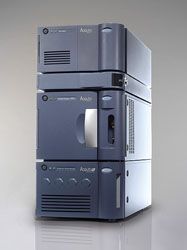Waters ACQUITY UPLC H-Class System
Designed to Replace HPLC Systems and Accelerate UPLC Adoption among HPLC Users

Waters® ACQUITY UPLC® H-Class System:
Designed to Replace HPLC Systems and Accelerate UPLC Adoption among HPLC Users
The new Waters® ACQUITY UPLC® H-Class System makes the productivity and chromatography performance benefits of UPLC accessible to HPLC users.
This combination of performance, simplicity and flexibility is designed to help more laboratories realize the scientific and business benefits of sub-2-μm (micron) particle column technology by making it more accessible to a broader range of industries, applications and operators.
Featuring a new quaternary solvent manager with flow-through needle design, the system allows those running HPLC methods access to UPLC-quality resolution, sensitivity, and speed. The system’s low-dispersion design results in high-efficiency separations while new method transfer kits along with three particle substrates in 11 chemistries – ranging in particle size from 5 micron to 1.7 micron – accommodates a broad range of applications and methods development approaches.
Waters ACQUITY UPLC H-Class System is built on UPLC technology which has proven to increase laboratory productivity, enable faster time-to-market, and increase profitability by reducing manufacturing costs, all while improving the quality of the information produced. Waters is now demonstrating the ACQUITY UPLC® H-Class System in all of its worldwide application laboratories and shipping units to customers. For more information: Click here.
Brian J. Murphy
Waters Corporation
+1 508-482-2614
brian_j_murphy@waters.com

Fundamentals of Benchtop GC–MS Data Analysis and Terminology
April 5th 2025In this installment, we will review the fundamental terminology and data analysis principles in benchtop GC–MS. We will compare the three modes of analysis—full scan, extracted ion chromatograms, and selected ion monitoring—and see how each is used for quantitative and quantitative analysis.
Characterizing Plant Polysaccharides Using Size-Exclusion Chromatography
April 4th 2025With green chemistry becoming more standardized, Leena Pitkänen of Aalto University analyzed how useful size-exclusion chromatography (SEC) and asymmetric flow field-flow fractionation (AF4) could be in characterizing plant polysaccharides.
This information is supplementary to the article “Accelerating Monoclonal Antibody Quality Control: The Role of LC–MS in Upstream Bioprocessing”, which was published in the May 2025 issue of Current Trends in Mass Spectrometry.




